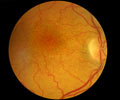Diabetic retinopathy, a complication of diabetes that can cause vision loss and blindness, can be reduced by injecting steroids into the eye, says a new study.
Diabetic retinopathy, a complication of diabetes that can cause vision loss and blindness, can be reduced by injecting steroids into the eye, says a new study.
Proliferative diabetic retinopathy occurs when new blood vessels form on the optic disc or another component of the retina. Controlling blood glucose levels can help prevent the development of retinopathy and laser treatments can reduce the risk of vision loss, but the identification of other treatments remains desirable.The researchers showed that steroid injections interfered with the creation of new blood vessels, possibly by reducing the production of compounds that spur their growth.
During the study, lead researcher Dr Neil M. Bressler, of Johns Hopkins University School of Medicine, Baltimore analysed 840 eyes of 693 participants who had macular edema, a leakage of fluid into part of the retina that occurs in many cases of retinopathy.
Eyes were randomly assigned to receive one of three treatments:
Photocoagulation (a laser treatment that destroys blood vessels) or a 1-milligram or 4-milligram injection of triamcinolone acetonide directly into the eye as often as every four months.
After two years, the research team found that retinopathy had progressed in 31 percent of 330 eyes treated with photocoagulation, 29 percent of 256 eyes treated with 1-milligram doses of triamcinolone acetonide and 21 percent of 254 eyes treated with 4-milligram doses.
Advertisement
"Use of this intravitreal [injected into the eye] corticosteroid preparation to reduce the likelihood of progression of retinopathy is not warranted at this time because of the increased risk of glaucoma and cataract associated with intravitreal steroid use," the authors write.
Advertisement
"Nevertheless, further investigation with regard to the role of pharmacotherapy for reduction of the incidence of progression of retinopathy appears to be warranted," they added.
The study appears in journal Archives of Ophthalmology, one of the JAMA/Archives journals.
Source-ANI
TRI















